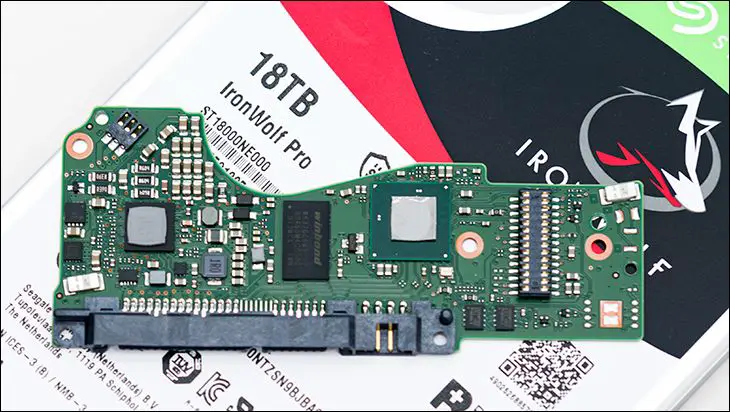Final Score: 94 out of 100
Let us start this summary by saying we apologize in advance. There is no way to wrap this model up in a pithy one liner, or simple analogy. This is a complicated model that can not just point to obvious improvements to sell it. Instead, there is a large elephant in room that has to be dealt with. One that is of Seagate’s own making and is simple: previous IronWolf Pros have set the bar awfully high, and all future models are going to be a victim of their own predecessors’ success. Furthermore, the last few generations all brought multiple, obvious and noteworthy selling points. That is a tough act to follow.
On first blush the Seagate IronWolf Pro 18TB is not that much different than the IronWolf Pro 16TB before it. It does not have those simple bullet point improvements to sell it to the masses. A cynical and jaded person could go as far as saying it is a rushed to market model. One where the foundation was laid multiple generations ago and Seagate has ‘simply’ swapped out the platters and done other ‘minor’ tweaks to their firmware to keep up with the competition.
Thankfully, such a first impression is not entirely accurate. The reality is that, while it is not a revolution and instead an evolution, the IronWolf Pro 18TB is impressive. It does have noticeable, real-world improvements over its predecessor… they just are not sexy sounding nor being hyped nearly as much. First and foremost, while the hardware is almost the same, it is more accurate to say it is similar. Give two top tier professional athletes the same set of clubs/bat/stick/ball/etc. and you will get different results. Especially if one of them is juicing harder than an aging Hollywood action star and the other skipped ‘leg (and arm) day’ for the past six months.
The most obvious is the change is from ~1.8TB to 2TB platters. This actually is a big deal. There are not many ways to increase performance of mature spinning platter technology. Right now the options are pretty much: you spin it faster (not going to happen as the negatives outweigh the positives for all but niche scenarios); use more platters (also not going to happen anytime soon as nine platters is pushing the limits of the 3.5inch form-factor); change the r/w technology (HAMR is obviously still not ready for prime-time); use independent r/w arms and actuators (Mach.2 is still too expensive for all but the high end Enterprise market); bring back the bigger 5.25-inch form-factor (a dream of ours that sadly is never going to happen)… or you increase the density of the data being stored.
The change from nine 1.8TB to nine 2.0TB platters is an eleven percent(ish) increase in density and it nets a nice boost in real-world performance. We saw this monster hit 268MB/s, stay at or above 260 for about three quarter(ish) of a Terabyte, above 250MB/s for ~5TB, 200MBs all the way to a whopping ~12TB… and even when filled stay above 122MB/s. A single hard drive outside the Enterprise market can now do that. In RAID configurations you can basically double that number. That is not Spam in a Can. That is a six-course meal prepared by a three-star Michelin chef. It just does not sound that impressive in press releases… as buyers have become jaded and expect such miracles to be commonplace.
To us though, the most impressive tweak is not even listed anywhere in the specs nor even highlighted that much in Seagate’s press material. That is the on-going refinement to their firmware and their MTC caching tech. It may not sound sexy, but while others are still fighting the capacity war (with proclamations of 512MB of cache) Seagate has further refined their 256MB backed algorithms. Yes, we would love to see them counter with 512MB, but we placed these is a NAS environment and monitored real-world performance vs. the 16’s and noticed an increase in cache hits. The more times the algorithms get it right… the more often you get a boost in overall real-world performance. This in conjunction with a bit more emphasis placed on lower queue depths easily justifies the asking price to enthusiasts and hard worked SMB NAS servers.
Lastly… yeah, the ‘Wolf Pro 18TB is going to set retail buyers back about $600. That is not as terrible as it first sounds. Six hundred is actually a noticeably lower price per TB for a flagship model than what the last gen IronWolf Pro 16TB’s MSRP on launch was. I doubt anyone can honestly argue that is anything other than a noteworthy improvement.
Taken as a whole, if you are not impressed by what Seagate was able to do… you have not been paying attention. It may not be flashy, it arguably is not being marketed optimally, and certainly is not a ‘revolutionary break through’ we have come to expect, but this new gen is a great evolution to an existing foundation. A firm foundation that has been further refined, and this refinement does pay tangible dividends. As such, if you can afford the asking price the Seagate IronWolf Pro 18TB easily justifies its professional moniker and its asking price – and then some. For those that cannot? Fear not, the release of this 18TB capacity model also means eventual price adjustment(s) to the smaller capacity models… and they are not chopped bits of mystery meat either – especially when they get 2TB platter tech in the future.
The Review
Seagate IronWolf Pro 18TB
It may not be flashy, it arguably is not being marketed optimally, and certainly is not a ‘revolutionary break through’ we have come to expect, but this new gen is a great evolution to an existing foundation.













